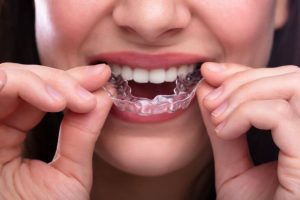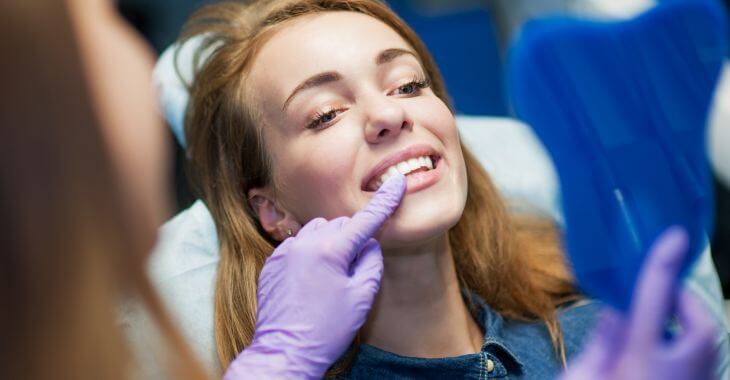Why Is Proper Bite Alignment Important?

A proper bite alignment is a vital part of achieving a healthy smile. It is not only about proper teeth alignment for aesthetics – a misaligned bite can affect teeth longevity, speech, overall health and more. Why is proper bite alignment so important? Here is what you need to know about achieving a proper bite – including what causes bite misalignment, risks, symptoms and treatments.
What Is Considered Proper Bite Alignment?
Proper bite alignment includes two factors – jaw alignment and proper teeth alignment. The upper and lower jaws need to be aligned correctly and the teeth require the right positions to fit together. Proper bite and teeth alignment is called occlusion. When teeth do not have proper alignment, it is called a malocclusion. It is not about whether the teeth look straight, but how the top and bottom teeth fit together. So, what is correct bite alignment?
- The lower jaw and teeth should fit into the upper teeth and jaw – the upper teeth should bite down on the outside of the lower teeth, but not enough to create a gap between the overlap.
- The side teeth alignment is a vital component of proper bite – the upper and lower teeth should fit together to create a solid wall of teeth.
- The upper canine tooth should fit between the lower canine and first premolar – this helps stabilize the bite to protect the jaw joint when chewing.
If the upper front teeth close behind the lower front teeth, it is called an underbite. If the upper teeth and jaw come down over the front lower teeth with a gap, this is an overbite. Both can cause problems with the appearance, function and health of the mouth and jaw.
What Causes Jaw or Teeth Misalignment?
Many jaw or teeth alignment issues are inherited or occur in childhood. How the teeth emerge, jaw structure and oral care during infancy, childhood and into the teen years impact correct teeth alignment. Malocclusions can be noticeable early on in childhood – orthodontic treatments can begin early to help guide the position of permanent teeth for better occlusion. Other factors that can impact proper bite alignment as you get older include:
- Missing teeth
- Dental appliances and restorations (crowns, fillings, bridges)
- Chipped or broken teeth
- Worn down teeth
- Health conditions – oral tumors, jaw injuries
In most cases, natural and proper bite alignment is genetic. Many people need dental and orthodontic treatments to achieve a proper bite, and changes to the jaw and teeth in adulthood can cause malocclusions later in life.
Problems Caused by a Misaligned Bite
Proper teeth alignment creates a beautiful smile and affects how your teeth and jaw function. When are your teeth or jaw not aligned properly, it can cause multiple problems for your oral health and mouth function. Some of the possible risks of teeth misalignment include:
- Difficulty or pain when chewing foods
- Impacts on speech due to the position of the teeth
- Premature wear on teeth and loss of enamel
- Teeth grinding, jaw clenching – this can cause additional damage to teeth
- Jaw pain or TMJ symptoms
- Misaligned teeth can be more difficult to clean and keep healthy, leading to decay, infections, tooth loss, gum disease and other dental problems
Misaligned bite and teeth can cause a multitude of oral health issues, beyond the effect to the aesthetics of the teeth. By creating proper bite alignment, you can avoid long-term oral problems. It is worth the investment to fix alignment issues, avoiding expensive and painful dental problems and treatments.

Creating Proper Bite and Teeth Alignment
Proper bite alignment should be monitored by dentists and orthodontists from an early age. Even baby teeth are important to guide permanent teeth into alignment. Most bite and teeth alignment can be managed through dental and orthodontic treatment in childhood, adolescence and teen years. Braces and clear aligners are the most common treatments for achieving the desired occlusion. In severe malocclusions, surgery may be required to adjust the jaw or teeth.
Once proper bite alignment is achieved, it is important to maintain the alignment. Keeping up with dental checkups, cleanings and needed tooth repairs can help reduce changes to your alignment. For those who had orthodontic treatment, wearing retainers at night can help maintain proper bite alignment. Some adults may need to seek further orthodontic treatment if changes to their teeth or jaw cause bite misalignment.
Creating proper bite alignment and straight, aligned teeth affect much more than the beauty of your smile. If your upper and lower teeth and jaw are properly aligned, it can help your teeth last longer and reduce your chance of many oral health problems. To achieve proper teeth alignment, see your dentist or orthodontist for treatment options. Once your smile is aligned, make sure to adhere to the recommended oral hygiene and dental checkups to maintain your oral health.
The information provided on this website, including text, graphics, images, and other materials, is intended solely for informational purposes and should not be used as a substitute for professional medical advice, diagnosis, or treatment.



)